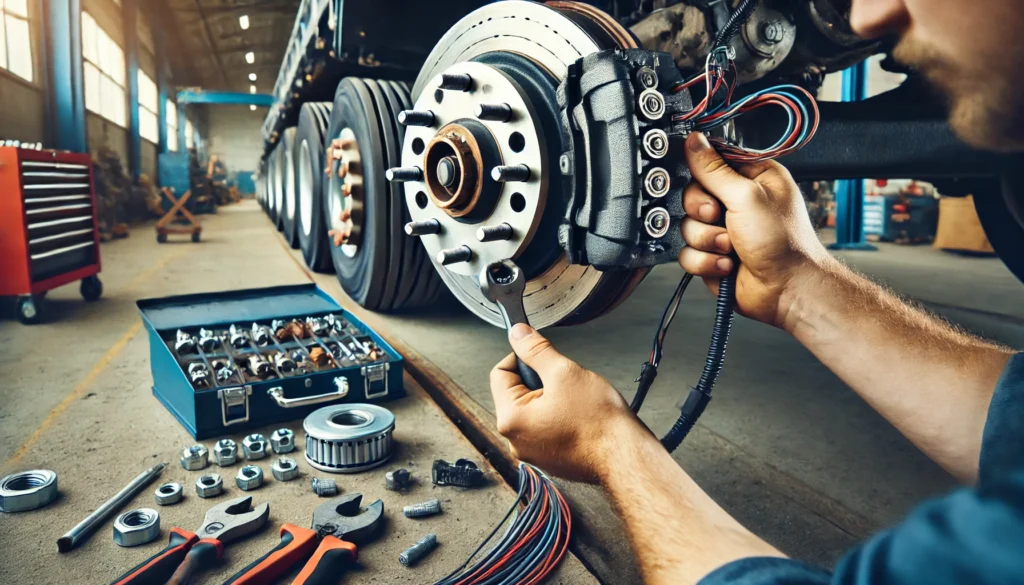When it comes to towing heavy trailers, having a strong and reliable braking system is essential for safety. For trailers with larger loads, 8 lug electric trailer brakes provide the stopping power necessary to ensure control on the road. In this comprehensive guide, we’ll explore what 8 lug electric trailer brakes are, how they work, their benefits, and essential tips for installation and maintenance.
What Are 8 Lug Electric Trailer Brakes?
8 lug electric trailer brakes refer to a braking system specifically designed for trailers with wheels that have eight lug bolts. These brakes are typically used on larger trailers, such as gooseneck trailers, heavy equipment trailers, and larger RVs, where the load requires more powerful braking capabilities. The “8 lug” refers to the wheel configuration, which can support heavier loads and provide increased stability during towing.
Electric trailer brakes work in conjunction with a brake controller installed in the towing vehicle. When the vehicle’s brakes are applied, the brake controller sends an electric signal to the trailer’s brakes, activating them to slow down the trailer in unison with the towing vehicle.
How Do 8 Lug Electric Trailer Brakes Work?
The operation of 8 lug electric trailer brakes is similar to other electric braking systems but designed for greater load capacity. Here’s how they function:
- Brake Controller Activation: When the driver presses the brake pedal in the towing vehicle, the brake controller sends an electric signal to the trailer’s brake assemblies.
- Magnet Engagement: This signal activates the magnets within the brake assemblies, pulling the brake shoes outward to engage with the brake drums.
- Friction Generation: The brake shoes press against the inner surface of the brake drums, creating friction and slowing the wheels of the trailer, which in turn stops the trailer.
- Proportional Braking: The brake controller adjusts the intensity of the braking force depending on how much pressure is applied to the towing vehicle’s brakes, ensuring smooth, proportional stops.

Benefits of 8 Lug Electric Trailer Brakes
8 lug electric trailer brakes offer several advantages for those towing heavy-duty trailers:
- Enhanced Safety: These brakes provide more control and stopping power, making it safer to tow heavy loads over long distances and steep grades.
- Proportional Braking: The brake controller allows for proportional braking, meaning the trailer’s brakes engage smoothly and in proportion to the towing vehicle’s brakes. This prevents trailer sway and ensures smoother stops.
- Greater Load Capacity: The 8 lug configuration allows the braking system to handle larger trailers with higher weight capacities, offering improved stability and performance during towing.
- Durability: Designed for heavy-duty use, 8 lug electric trailer brakes are built to last, offering increased durability for frequent towing of large loads.
- Cost-Effective: Electric brakes are generally more affordable and easier to maintain than hydraulic systems, making them a cost-effective choice for larger trailers.
Installing 8 Lug Electric Trailer Brakes
Installing 8 lug electric trailer brakes requires a bit of mechanical know-how, but the process is straightforward if you have the right tools. Here’s a step-by-step guide to help you with the installation:
1. Prepare the Trailer
Park the trailer on a flat, level surface and secure it with wheel chocks. Use a jack to lift the axle so that the wheels can be removed safely.
2. Remove Old Components
If your trailer has an existing brake system, remove the wheels, brake drums, shoes, and any related components. Clean the axle flange and surrounding areas to prepare for the new brake assemblies.
3. Install the New Brake Assemblies
Mount the new 8 lug brake assemblies onto the axle flanges, securing them with the provided hardware. Make sure the assemblies are properly aligned with the wheel hubs for correct operation.
4. Connect the Wiring
Run the wiring from the brake controller in the towing vehicle to the trailer’s brake assemblies. Ensure that all connections are secure and protected from moisture or corrosion to avoid electrical issues.
5. Install the Brake Drums
Once the brake assemblies are in place, slide the brake drums over the assemblies, ensuring a proper fit. Reinstall the wheels and tighten the lug nuts to the manufacturer’s specifications.
6. Test the Brakes
Before towing, test the brakes by driving slowly in a safe area and applying the brakes. Adjust the brake controller settings as needed to ensure smooth and proportional braking.
Maintenance Tips for 8 Lug Electric Trailer Brakes
Maintaining your 8 lug electric trailer brakes is essential for ensuring their long-term performance and safety. Here are some key maintenance tips:
- Regular Inspections: Check the brake shoes, magnets, and drums for wear and tear. Replace any worn components promptly to maintain optimal braking performance.
- Clean the Brake Assemblies: Over time, dirt, debris, and rust can accumulate on the brake components. Regularly clean the brake assemblies to keep them functioning smoothly.
- Check the Wiring Connections: Inspect the wiring for damage, corrosion, or loose connections. Repair or replace any faulty wiring to prevent electrical problems that could affect braking performance.
- Adjust the Brake Controller: Depending on the weight of your trailer and the load you are towing, you may need to adjust the brake controller settings to provide the appropriate amount of braking force for safe towing.
Conclusion
8 lug electric trailer brakes are a must-have for anyone towing heavy loads. Their ability to provide powerful stopping power, smooth braking, and enhanced control makes them an essential component of any heavy-duty trailer setup. By installing these brakes and performing regular maintenance, you can ensure that your trailer remains safe and secure on the road, even under the most demanding towing conditions.
